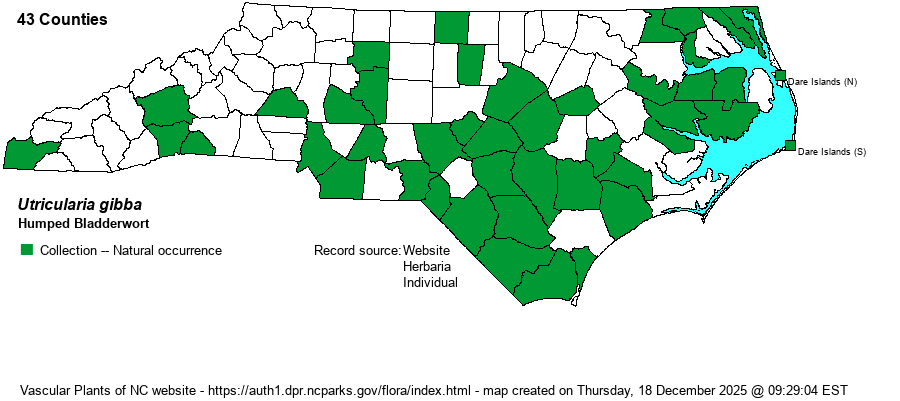| Author | L. | |
| Distribution | Scattered over much of the Coastal Plain, the Piedmont, and edge of the Mountains (Cherokee, Henderson, and Buncombe counties). This is a tiny species and is easily confused with U. biflora. One of the website editors (Sorrie) has examined the specimens at NCU and concurs with the ID of specimens from Brunswick, Currituck, Gates, Harnett, Henderson, Hertford, Mecklenburg, Tyrrell, and Washington counties. Outer Banks (Dare County) specimens are at herbarium NCSC. In 2022, Sorrie confirmed the following Piedmont counties: Caswell, Cherokee, Davidson, Forsyth, Henderson, Mecklenburg, Rowan, Stanly, Union, Wake (Polk and Buncombe counties records were without image). Weakley's (2024) map shows it as widespread and numerous across the state, and the VA atlas map shows it as widespread across the eastern half of that state.
This is a rather Northern species of Utricularia, ranging across much of Canada and south to FL and LA.
| |
| Abundance | Infrequent in the Coastal Plain, rare in the Piedmont and southern Mountains. | |
| Habitat | This is another bladderwort found essentially in shallow, still fresh water, being found in pools, lake and pond margins, wet ditches, and other places with some shallow water. |
| Phenology | Blooms from May to September, and fruits shortly after flowering. | |
| Identification | This species is very similar to U. biflora and taxonomists have treated it as a variety or lumped entirely. U. striata and U. floridana are also quite similar, though they are much larger plants, have much larger flowers, and have shoots/leaves of two types, one with many bladders/traps and others with essentially no traps. U. gibba is best told by its tiny size, the smallest of the "mat-forming" group of yellow-flowered bladderworts, with a flowering scape only reaching about 2 inches tall and with a very small bright yellow flower (or two) that has a blunt spur only about 4 mm long (1/6-inch long). (The entire flower is barely 1/4-1/3-inch long and across.) The spur is stout and blunt, and shorter than the lower lip. The leaf segments (all with tiny bladders) are branched only once or twice, as in U. biflora. U. biflora has a larger flower, and a long and pointy spur that usually exceeds the lip. As might be expected, to properly identify any of these four species, you almost certainly will need to pull a few plants out of the water and examine the flower and leaf structure, probably under a hand lens or microscope. At least, the tiny flower size should suggest U. gibba even without examining the leaves. | |
| Taxonomic Comments | As mentioned above, more references than not include U. biflora as a variety of U. gibba. Weakley (2018) does split them, with some hesitancy, and even states "intermediates will be encountered". U. gibba is the one that is consistently listed as a valid species.
| |
| Other Common Name(s) | Floating Bladderwort, Creeping Bladderwort | |
| State Rank | S4 [S4?] | |
| Global Rank | G5 | |
| State Status | | |
| US Status | | |
| USACE-agcp | OBL link |
| USACE-emp | OBL link |

